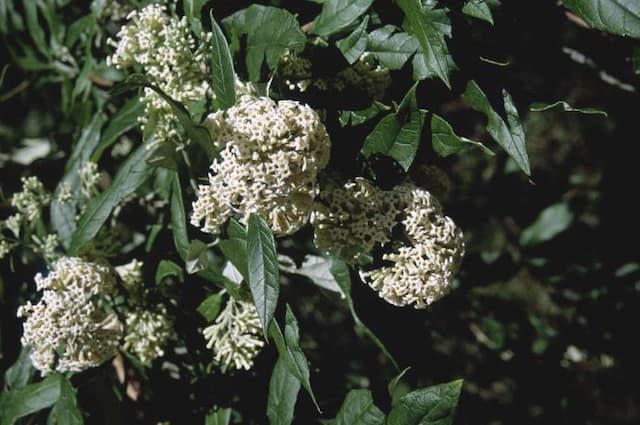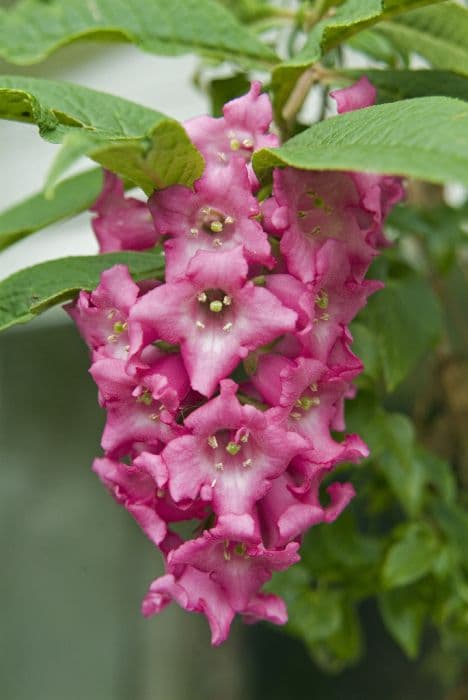Cape figwort 'Aylesham's Pride' Phygelius × rectus 'Aylesham's Pride'

ABOUT
'Aylesham's Pride' is an evergreen shrub (herbaceous in cold areas) with ovate leaves and loose panicles of nodding, dusky pink flowers in summer, marked with yellow and red in the throat
About this plant
 Names
NamesFamily
Scrophulariaceae
Synonyms
Cape Fuchsia, Aylesham's Pride
Common names
Phygelius × rectus 'Aylesham's Pride'.
 Characteristics
CharacteristicsLife cycle
Perennials
Foliage type
Semi-deciduous
Color of leaves
Green
Flower color
Salmon
Height
3 feet (0.91 meters)
Spread
2 feet (0.61 meters)
Plant type
Shrub
Hardiness zones
7
Native area
South Africa
Benefits
 General Benefits
General Benefits- Attracts Pollinators: The tubular flowers of Cape Fuchsia 'Aylesham's Pride' are highly attractive to bees, hummingbirds, and butterflies, promoting biodiversity in the garden.
- Long Blooming: It has a long flowering season, from early summer to autumn, providing extended visual interest in the landscape.
- Drought Tolerance: Once established, Cape Fuchsia 'Aylesham's Pride' is quite drought-tolerant, making it suitable for low-water gardens.
- Visual Appeal: The bright salmon-pink flowers with a yellow throat provide a splash of color that can brighten up borders, beds, and containers.
- Low Maintenance: It is generally easy to care for, requiring minimal upkeep beyond regular watering and occasional pruning.
- Resilience: Cape Fuchsia 'Aylesham's Pride' is relatively resistant to pests and diseases, ensuring fewer losses and less need for chemical treatments.
- Versatility: Can be used in a variety of garden settings, including mixed borders, cottage gardens, and as a statement plant in a container.
- Fast Growth: It grows quickly, allowing gardeners to establish a mature and attractive display in a relatively short amount of time.
- Deer Resistance: Although not completely deer-proof, Cape Fuchsia 'Aylesham's Pride' is not a preferred plant for deer, reducing the likelihood of damage in areas with deer populations.
 Medical Properties
Medical PropertiesThis plant is not used for medical purposes.
 Air-purifying Qualities
Air-purifying QualitiesThis plant is not specifically known for air purifying qualities.
 Other Uses
Other Uses- The nectar-rich flowers of the Cape Fuchsia can be used to attract hummingbirds and beneficial pollinators to the garden, serving as a natural way to enhance pollination of nearby plants.
- Cape Fuchsia can be planted in outdoor living spaces to add vibrant color and aesthetic appeal due to its tubular flowers and bright foliage.
- It can serve as a privacy screen when planted in a row or grouping due to its bushy growth habit and quick growth.
- The stems and flowers can be used in flower arrangements for bouquets, providing a unique and long-lasting floral display.
- Cape Fuchsia can be utilized in erosion control on slopes or banks as its root system helps to stabilize the soil.
- This plant can be used in thematic gardens, such as a cottage garden or wildlife garden, to create a particular visual and ecological atmosphere.
- The dried seed pods of Cape Fuchsia can be used in craft projects for decoration, adding a natural element to wreaths and other DIY crafts.
- As a fast-growing plant, Cape Fuchsia can be used to quickly fill in bare areas in the landscape, providing green coverage in a short time span.
- The plant can be used in educational settings, like school gardens, to teach children about plant growth, wildlife attraction, and gardening techniques.
- During themed events or parties, Cape Fuchsia can be used for temporary garden decorations to enhance the space with its striking blooms and foliage.
Interesting Facts
 Feng Shui
Feng ShuiThe Cape Fuchsia is not used in Feng Shui practice.
 Zodiac Sign Compitability
Zodiac Sign CompitabilityThe Cape Fuchsia is not used in astrology practice.
 Plant Symbolism
Plant Symbolism- Perseverance - The Phygelius × rectus 'Aylesham's Pride', commonly known as the Cape Fuchsia, is a hybrid plant that thrives in various conditions, symbolizing the ability to endure and persist.
- Attraction - With its vibrant, trumpet-shaped flowers, the Cape Fuchsia is often associated with attraction and magnetism, implying a pull or draw to something desirable.
- Protection - In some cultural beliefs, the Cape Fuchsia is thought to ward off negative energies, representing spiritual or physical protection.
- Adaptability - Cape Fuchsia's flexible growing requirements signify adaptability to diverse environments and situations.
 Water
WaterCape Fuchsia should be watered deeply but infrequently to mimic natural rainfall patterns. Aim to water the plant when the top inch of soil feels dry, which may mean once a week during the active growing season, depending on your climate. Reduce watering in the winter when the plant is not actively growing. When you do water, soak the soil thoroughly, using approximately 1-2 gallons of water for an established plant to ensure moisture reaches the deep roots.
 Light
LightCape Fuchsia thrives in a location that receives full sun to partial shade. Ideally, it should receive at least six hours of sunlight daily, which promotes healthy growth and abundant flowering. A spot that is sunny in the morning but shaded during the hottest part of the afternoon is ideal to prevent stress from excessive heat.
 Temperature
TemperatureCape Fuchsia prefers a temperate climate and does well in temperatures ranging from 50 to 75°F. It can survive minimum temperatures down to around 20°F but may sustain damage if exposed to colder conditions for prolonged periods. Ensure the plant is situated in a spot that avoids frost pockets to maximize its potential for healthy growth.
 Pruning
PruningPrune Cape Fuchsia in late winter or early spring to encourage bushy growth and improve airflow within the plant. Remove any dead or damaged stems, and cut back last year's growth by about a third to promote new shoots. Pruning can be done annually, and the best time is just before the new growth begins as the temperatures start to rise.
 Cleaning
CleaningAs needed
 Soil
SoilCape Fuchsia 'Aylesham's Pride' thrives in well-drained, fertile soil with a pH range of 5.5 to 6.5. The best soil mix for Cape Fuchsia would be equal parts loam, peat, and sharp sand to ensure proper drainage and fertility needed for optimal growth.
 Repotting
RepottingCape Fuchsia 'Aylesham's Pride' should be repotted every two to three years or when it becomes root-bound. Spring is the ideal time for repotting to allow the plant to establish in its new pot before the growing season.
 Humidity & Misting
Humidity & MistingCape Fuchsia 'Aylesham's Pride' prefers moderate humidity levels but is quite adaptable to a range of conditions. It can tolerate some dry air but thrives in an environment with consistent, moderate humidity without special requirements.
 Suitable locations
Suitable locationsIndoor
Provide bright, indirect light and keep the soil moist for Cape Fuchsia.
Outdoor
Plant in sun or part shade, protect from harsh winds for Cape Fuchsia.
Hardiness zone
7-10 USDA
 Life cycle
Life cycleThe life cycle of Phygelius × rectus 'Moonraker', commonly known as Cape Fuchsia, begins with germination, where the plant emerges from seeds under suitable conditions of warmth and moisture. It then enters the vegetative growth phase, developing a rosette of leaves and establishing a root system. As it matures, Cape Fuchsia enters the flowering stage, producing tubular flowers that are attractive to pollinators like hummingbirds and bees. Following pollination, the plant produces small capsules containing seeds, completing the reproductive cycle. When environmental conditions are favorable, the seeds disperse, potentially giving rise to new plants. During its perennial life span, Cape Fuchsia may enter a dormancy phase during colder months and regrow from the existing root system when the weather warms.
 Propogation
PropogationPropogation time
Spring to early summer
The Cape fuchsia, Phygelius × rectus 'Aylesham's Pride', is commonly propagated via softwood cuttings, a method best performed in late spring or early summer. To propagate using this method, a gardener should select healthy, non-flowering shoots and cut sections about 3-5 inches (approximately 7.5-12.5 cm) long. The lower leaves of these cuttings are removed, and the base of the cutting is dipped in a rooting hormone to enhance root development. These prepared cuttings are then placed in a well-drained potting mix, ensuring that at least one node is below the soil surface where roots can develop. The pot containing cuttings should be kept in a warm, humid environment to encourage rooting, often by covering it with a plastic bag or placing it in a propagator. Roots typically form within a few weeks, after which the new Cape fuchsia plants can be transferred to individual pots and eventually planted out.

![Butterfly bush [Berries and Cream]](/_next/image?url=https%3A%2F%2Fplants-admin.emdemapps.com%2Fimages%2Fplants%2F%2Fimages%2F604b650f667be.png&w=640&q=75)






